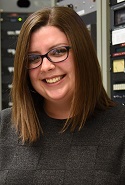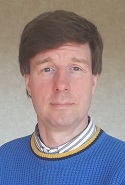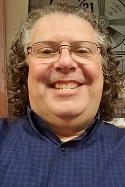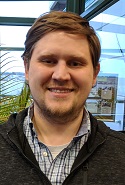Our Next Chapter Meeting
|

Britny Williams Chair |

Mike Norton Vice Chair |

Russ Awe Secretary |

Roy Henn Treasurer |
The election process will close at the end of the Chapter's April 24th monthly meeting. Election results will be announced in the May issue of eNews with the new Officers assuming their duties at the Chapter's May 23rd meeting.

Groth to WBA Hall of Fame
Shortly after Clif's first radio job in Watertown in 1958, he started his own Contract Engineering business and proceeded to make in impact on stations all over the state of Wisconsin. His client list also included stations in Michigan, Illinois, Iowa, Minnesota, and Missouri. Over the years Clif was called on to build new towers, tower arrays, install new or backup transmitters, build new studios, build a farm network, automate many stations, setup station streaming, add digital radio, increase station power, and even engineer sports play by play broadcasts. He has seen and done just about everything possible in the profession of radio engineering.
Clif is always there to share his knowledge for his fellow engineer. Many a colleague has Clif's number and knows that the answer to a tough problem, the location of that rare repair part, or access to loaner equipment and test gear are only a phone call away. In fact if the call invokes his curiosity, Clif has been known to show up on site to lend a hand toward fixing the problem or completing the project. In the past 60 plus years, many a broadcast engineer around the state got their start as Clif's assistant. They were truly mentored by the best.
Clif is "retired" but still watches over Fort Atkinson radio, serves on the program committee for the WBA Broadcasters Clinic, does FCC Alternate Inspections for the WBA, and still handles consulting and measurements for radio broadcasters. Congratulations Clif!
28 Years Ago....
Last Meeting's Minutes
Submitted by Tom Smith, acting Secretary
SBE Chapter 24 held its monthly meeting on March 28th at Full Compass Systems. Chairman Richard Wood called the meeting to order at 7:06 PM. The minutes from the February meeting were accepted as published in the March newsletter.
Treasurer Roy Henn reported that the Chapter had received renewal checks from four chapter sustaining members. Chairman Rich Wood reported that there were 14 sustaining members and 48 paid members of the chapter.
Chairman Rich Wood gave the upcoming program schedule with the April 24th meeting to be the election of new officers and an NAB overview to be held at WISC-TV. The May 23rd meeting will be a presentation from Werner Electric on Data Com 4K connectors, the June meeting will be the WBA Summer Conference on June 12th at the Osthoff Resort in Elkhart Lake, the July 25th meeting will be at WISC-TV with a presentation on tower maintenance by Tower MRL, and the August 28th meeting will be a tour of the remodeled WHA radio studios.
Leonard Charles announced that the deadline for the April Newsletter was end of the business day on Monday, April 1st.
Certification Secretary Jim Hermanson announced that Tim Trendt has received his re-certification as a Certified Broadcast Technologist. Jim mentioned that viewing the SBE Web Extra video webinars were worth 1/2 credit for recertification, Jim also listed the upcoming webinars from the SBE and noted that the next certification exams would be from June 7th through June 17th, with the application deadline being April 19th.
Frequency Coordinator Tom Smith reported he had received a coordination request for an event at Road America, which he referred the group requesting the coordination to the Green Bay and Milwaukee coordinators. He also mentioned that in a couple of recent speeches by FCC Commissioner O'Reilly it was likely the FCC would allocate the C-band satellite spectrum to 5G wireless use and allow indoor Wi-Fi use on the 6 and 7 GHz TV fixed and mobile microwave bands.
Leonard Charles reported on national SBE news. The national SBE membership meeting at the NAB Convention will be held on Tuesday, April 9th at 5 PM with a reception at 6 PM. There will be an Ennis Workshop on Saturday, April 6th from 9AM to 12 PM. The SBE will also be offering a full day ATSC 3.0 tutorial at the Flamingo Hotel in conjunction with the PBS TechCon. It is open to everyone, with a registration deadline of April 1st at ww.sbe.org. The SBE Compensation survey starts on April 1st and membership renewals are due on April 1st. He noted that the SBE National Convention will be coming to Madison and will be held in conjunction with Broadcasters Clinic.
Leonard Charles also announced the candidates for the election of Officers at the April Meeting, The candidates are Britny Williams for Chairman, Mike Norton for Vice-Chairman, Russ Awe for Secretary, and Roy Henn for Treasurer. Electronic voting will start on April 1st and end on April 24th on the chapter website, with downloadable paper ballots on the website and at the next meeting. There will be a link on the website.
There was no old business and in new business, Chairman Rich Wood announced that there was a need for volunteers to help with the SBE booth and for the video streaming production of the national meeting.
The meeting was adjourned and Kevin Peckham from Full Compass introduced a representative of Pliant who gave a presentation on their Crewcom Wireless intercom system.
Amateur Radio News
compiled by Tom Weeden WJ9H
An FCC Enforcement Bureau agent who monitored transmissions on 95.7 MHz from "Amateur Radio station KE6WMS" in the FM broadcast band on January 31, 2019, observed violations of §97.103 -- not operating in accordance with FCC rules; §97.113(b) -- prohibited transmissions, i.e., broadcasting, and §97.301 -- operation outside frequency bands authorized for Amateur Radio. The FCC ordered Thomas to respond in writing within 20 days, explaining each violation and actions taken to correct them and prevent their recurrence.
Last October 10, an Enforcement Bureau agent responded to a complaint of an unlicensed FM station operating on 95.7 MHz in Carmichael. The agent confirmed by direction-finding techniques that a signal on 95.7 MHz was emanating from a residence, and Thomas subsequently admitted that he was the operator of this station, the FCC said in the NoUO. The agent measured the field strength of the signal and found that it exceeded the maximum permitted level of 250 μV per meter at 3 meters, established for unlicensed operation in accordance with FCC Part 15 rules. Despite FCC warnings last fall, the transmissions apparently continued into this year.
In what may be a first in the effort to crack down on unlicensed broadcasters, the United States has filed a civil action to stop a church-related pirate radio station from operating in Worcester, Massachusetts. The Massachusetts US Attorney's Office is seeking an injunction to shut down the station, operating on 97.1 MHz.
"This groundbreaking step, for an injunction to stop a pirate radio operator's illegal activities, is part of our continued efforts to combat illegal broadcasting," FCC Enforcement Bureau Chief Rosemary Harold said this week. "As we work with our law enforcement colleagues to use every tool in our toolbox to combat pirate radio, I welcome the Justice Department's renewed use of its Section 401(a) injunction authority. Along with fines, equipment seizures, and warnings, this action underlines our continued interest in combatting this serious problem."
The FCC already has fined operator Vasco Oburoni and Christian Praise International Church $15,000 for repeated violations of its rules against unlicensed operation. The complaint recounts that Oburoni and the church first began operating an unlicensed station in Worcester on 102.3 MHz. After issuing multiple warnings, the FCC levied the $15,000 penalty, and Oburoni agreed to a payment plan. But later, he began broadcasting again, this time on 97.1 MHz. At least one licensed broadcaster has complained to the FCC, citing interference concerns.
The GPS network will encounter a small millennium bug of its own in April when the network's "week number" rolls back to zero. This known issue especially could affect those who use GPS to obtain accurate Coordinated Universal Time (i.e., UTC). In the GPS network, the number of the current week is encoded into the message the GPS receives using a 10-bit field. This allows for weeks ranging from zero to 1023. The current period began on August 1, 1999. On April 6, 2019, the week number rolls over to zero and starts counting back up to 1023. This should not affect later-model GPS receivers that conform to IS-GPS-200 and provide UTC, but testing carried out by the US Department for Homeland Security (DHS) raised the possibility that some units may misinterpret the rollover, shifting the date back to January 6, 1980, or possibly to another incorrect date. An affected GPS not only may report the incorrect date, but time accuracy that is critical to precise location data could be compromised. A nanosecond error in GPS time can equate to 1 foot of position (ranging) error, according to DHS-published guidelines that explain the issue and suggest how to address it.
(Excerpts from the American Radio Relay League's arrl.org web site)
FCC NEWS
compiled by Tom Smith
LPTV AND FM REPACK REIMBURSEMENT RULES ISSUED
On March 15th the FCC issued a Report and Order (FCC-19-21A1) that defined the rules for LPTV, TV translators and FM stations on their eligibility for receiving reimbursement for expenses that they may occur due to the repacking of TV stations on facilities that they may share. LPTV and TV translators may be able to seek reimbursement if they were displaced by full power TV or Class A low power TV stations, had applied and received a construction permit for a new channel, and had been on the air for 9 of the 12 months ending on April 13, 2017. FM stations may apply for reimbursement if they need to move to a permanent new transmitter location, have to build or modify an auxiliary transmitter site in order to remain on the air during work at their normal transmitter site or to modify their main or auxiliary equipment such as antennas at their current site to remain on the air during construction. The work does not have to be on a tower that the FM station shares, but could be a nearby adjacent tower where the FM station radiation pattern causes an RF safety standards issue on the tower being worked on. FM stations also need to have been on the air as of April 13, 2017 in order to apply for reimbursement.Filing for any of these stations now eligible for reimbursement because of repack will be similar to the filing that applies to full power and Class A stations. The FCC estimates about 500 FM stations may be eligible to seek reimbursement due to construction of new or modified facilities because of the repacking of TV stations on facilities they share.
The FCC also released a notice (DA-19-176A1) on March 15th explaining the reimbursement decisions and a list (DA-19-176A2) of the acceptable amounts for items that can be reimbursed.
TV WHITE SPACE RULES UPDATED
In an action on March 13th, the FCC modified a number of rules pertaining to the use of TV White Space devices for broadband data transmission. In the Report and Order (FCC-19-24A1), the FCC changed the rules pertaining to the determination of the location of a TV white space device and its reporting of the TV white space device's location to the White Space database. The rules previously required the use of a professional installer of which there were no qualification requirements to determine the location of the transmitter and enter that location in the TV white space database. The database shared by a number of companies is used to determine open TV channels that the device could operate on. The database contains information on nearby TV stations from FCC data and wireless microphones which are registered with the TV white space database. The new rules will now require all TV white space transmitters to use geo-location (GPS) to determine location. The GPS receiver can be installed in the transmitter or externally. The transmitter must be located no more than 50 meters from the GPS receiver which allows an indoor unit to connect to the GPS unit which must be located outside the building to receive the signal from the GPS satellites. The white space transmitter must contact the white space database once a day or whenever it begins operation after being installed, shut down or moved to report its location and find the open TV channels that it may operate on.Another set of rule change the FCC made concerns antenna height. The FCC did not change the antenna height restrictions on low power units which are 40 milliwatts for low power units on channels adjacent to TV stations and 100 milliwatts on units that are located 2 channels from any TV stations. The height limit for these stations is 10 meters above ground. For the higher power units, white space units operating with 4 watts EIRP are still limited to 30 meters above ground and 250 meters above average terrain. For sparsely populated areas which the FCC considers to be areas with available TV stations numbering less 50% of the number of stations in that particular TV band, TV white space transmitters can operate with up to 10 Watts EIRP at up to 100 meters above ground, but retain the 250 meter above average terrain limitation. Antenna height must be entered into the white space database manually when the transmitter is installed or moved. If the height of the transmitter antenna is higher than the FCC limits, the database will not update the unit which will restrict its operation. While an installer may enter the information into the TV white space database, the operator of the TV white space device is responsible for the accuracy of the information.
The FCC will require the manufactures of TV white space equipment to have all new equipment certified 6 months after the new rules go into effect, but will allow existing equipment under the old certification to be sold for up to 18 months after the rules take effect. Existing equipment already in service will not need to be replaced.
A number of other rules changes were discussed such as changes in power limits in low power units and changes in omnidirectional and directional antenna restrictions. The FCC took no actions on these possible rule changes and a number of other proposals.
REAUTHORIZATION OF TV SATELLITE STATIONS EASED
The FCC made it easier for the reauthorizations of TV satellite stations when such stations are sold. TV satellite stations are full power TV stations that rebroadcast another commonly owned station and are used in areas were a station is unable to operate with locally produced programming because of the lack of available advertising revenue. The FCC would like that all stations provide local programming, but that is not possible in markets with low populations. Satellite stations do not count these stations against ownership limits.When a station is sold, it must certify that circumstances for the authorization of the satellite station has not changed and must submit a copy of the existing authorization. Previously a full authorization request for a satellite station had to be made when the satellite station and its parent station were sold. Now the FCC is requiring a less extensive filing to be submitted.
Because of the past FCC restrictions on satellite stations, there are few satellite stations with most in the northern plains states.
The notice can be found at FCC-19-17A1. This action was taken on March 11th.
FCC PLANS LPTV/TRANSLATOR AUCTION
On March 29th, the FCC issued a notice (DA-19-229A1) seeking comment on the procedures for bidding in an auction for LPTV and TV translator licenses. This a limited auction only affecting LPTV and TV translator stations that are being displaced by the repacking of the TV bands and have mutually exclusive applications for the same replacement channel. These stations have lost their channel either by a full power station or a Class A low-power station being moved to their previous channel or they were in the portion of the TV band that was reassigned to wireless use. This auction only affects 19 stations in 5 large TV markets, they include New York/West Orange, NJ, San Francisco/Santa Cruz, CA , Austin, TX, Miami, FL and Bakersfield, CA. Here is a link to a list of stations and markets involved (DA-19-229A2).Considering the number of LPTV and TV translators displaced and the reduced number of TV channels available, the fact that there is only 19 stations that were unable to find a new channel without conflict is amazing.
The FCC also lifted a freeze on applications for LPTV and TV translators for displacement and digital companion channels. The freeze was enacted to allow some LPTV and TV translator stations that were displaced by the full power and Class A TV station the first opportunity to find a new channel. The stations covered by this notice are those that have to exit channels in the new wireless band that will occupy channels 38 through 51. The applications will be accepted starting on April 18th. The notice can be found at (DA-17-1033A1).
QUARTERLY REPORTS WAIVED FOR CERTAIN REPACK STATIONS
The FCC is waiving the requirement for stations in phase 3, 5 and 8 to file quarterly progress reports on their repack status. Stations in phase 3 will not have to file their report due April 10th, phase 5 will not have to file their quarterly report due July 10th and phase 8 stations will not have to file their quarterly report due on January 10, 2020. They will still be required to file their report due 10 weeks before their transition. The reason for the waiver is that the dates the quarterly progress report and the 10 week report before the transition date of these three phases fall nearly at the same time and would be duplicative. The notice (DA-19-228A1) was issued on March 28th.EEO ENFORCEMENT MOVED
On March 15th, the FCC issued a press release (DOC-356581A1) that a change in Equal Employment Opportunity enforcement had been moved to the Enforcement Bureau had been published in the Federal Register and was now in effect. The Enforcement Bureau will now receive all EEO complaints and do all of the audits of EEO programs by broadcast stations, cable systems and satellite TV and radio providers. This action was voted upon in 2018 and required negotiations with the National Treasury Employees Union before it could take effect.DONE DEAL
In two recent speeches given by FCC Commissioner Kevin O'Reilly, he stated that it was likely that the C-band satellite spectrum would be allocated for 5G broadband use and that the 6 and 7 GHz TV microwave band would have an allocation added for Wi-Fi use. Any Wi-Fi use in the 6 and 7 GHz TV microwave band would be limited to indoor use to prevent interference to TV operations. The speeches were given to an NAB Leadership Conference on February 26th and the American Cable Association (now called the American Communications Association) on March 20th.In the NAB speech (DOC-356361A1), he stated the following about the C-Band allocation:
Certification and Education
compiled by Jim Hermanson
Congratulations to Timothy Trendt of UW-Platteville for recertification as a Certified Broadcast Technologist (CBT)!
The Open 2019 Exam Schedule
| Exam Dates | Location | Application Deadline (to SBE National Office) |
| Jun 7-17, 2019 | Local Chapters (Madison Area) | April 19, 2019 |
| August 2-12, 2019 | Local Chapters (Madison Area) | June 3, 2019 |
| November 1-11, 2019 | Local Chapters (Madison Area) | September 24, 2019 |
A reminder that each year, account balance permitting, Chapter 24 will reimburse half the application fee to any member of Chapter 24 in good standing who successfully obtains any SBE certification level not previously held by that member.
When you are ready to take an SBE exam, please fill out the appropriate application and send it into the SBE National office (see address below). You will be notified once your application has been approved. Approximately 3 weeks before the exam time, your local certification chairman will receive a list of applicants in his/her area. He/she will then contact those applicants to schedule a date, time and place for the exams. The exams will be mailed back to the National office for grading. The pass/fail grades will then be mailed directly to the applicants.
|
Megan E. Clappe Certification Director 9102 N. Meridian St. Suite 150 Indianapolis, IN 46260 317-846-9120 Fax mclappe@sbe.org |
Participate in the 2019 Mentor Program
The SBE Mentor Program is now in its third year and off to a great start in 2019 with new pairings and another Kick-Off webinar. Of course, we welcome more mentors/mentees to the program. Contact Education Director Cathy Orosz at 317-846-9000 or corosz@sbe.org.If you are attending the NAB Show in Las Vegas, be sure to add the SBE Membership Meeting on Tuesday, April 9 to your schedule. Don't miss this opportunity to meet mentors and mentees face-to-face and be recognized for your participation in this program!
If you are planning on attending the NAB Show, email Education Director, Cathy Orosz at corosz@sbe.org so we will be sure to look for you.
April Webinar
Wednesday, April 17, 2019RF 201 Module 6: RF System Diagnostic Measurements
Richard Wood, President of Resonant Results presents. He will focus on the means and methods for testing antenna systems and what the information/data means. With the Repack in full swing, it is important for station Engineers to have a good understanding of the test data they will receive on their new antenna systems plus existing systems should have a good base line data on hand for when problems arise. A brief discussion of the care and handling of tower contractors will also be covered.
Members $59. MemberPlus Members FREE and Non-Members $89. Register Here.
Several On-Demand Webinars ranging from ATSC 3.0 to cybersecurity to networking to RF courses are available HERE.
Look forward to the SBE RF 201 Series that will continue in 2019. Please take advantage of Modules 1-4 that are now available ON DEMAND.
The RF Safety 2019 course has been set for Thursday, May 2.
Recertification Credits for SBE WEBxtra
For those holding SBE certification, viewing the SBE WEBxtra qualifies for 0.5 points in category G (attendance), just like attending a local chapter meeting.ATSC 3.0 Tutorials at PBS TechCon 2019
At least three tutorials on ATSC 3.0 will be offered at PBS TechCon 2019. For more information, see the listings under 2019 News and Headlines on this page.Views expressed herein do not necessarily reflect the official position of the Society of Broadcast Engineers (SBE), its officers, or its members. SBE Chapter 24, Inc. regrets, but is not liable for, any omissions or errors. Articles of interest to Chapter 24 members are accepted up to the close of business the 1st day of each month. Send your article to lcharles@sbe.org .

